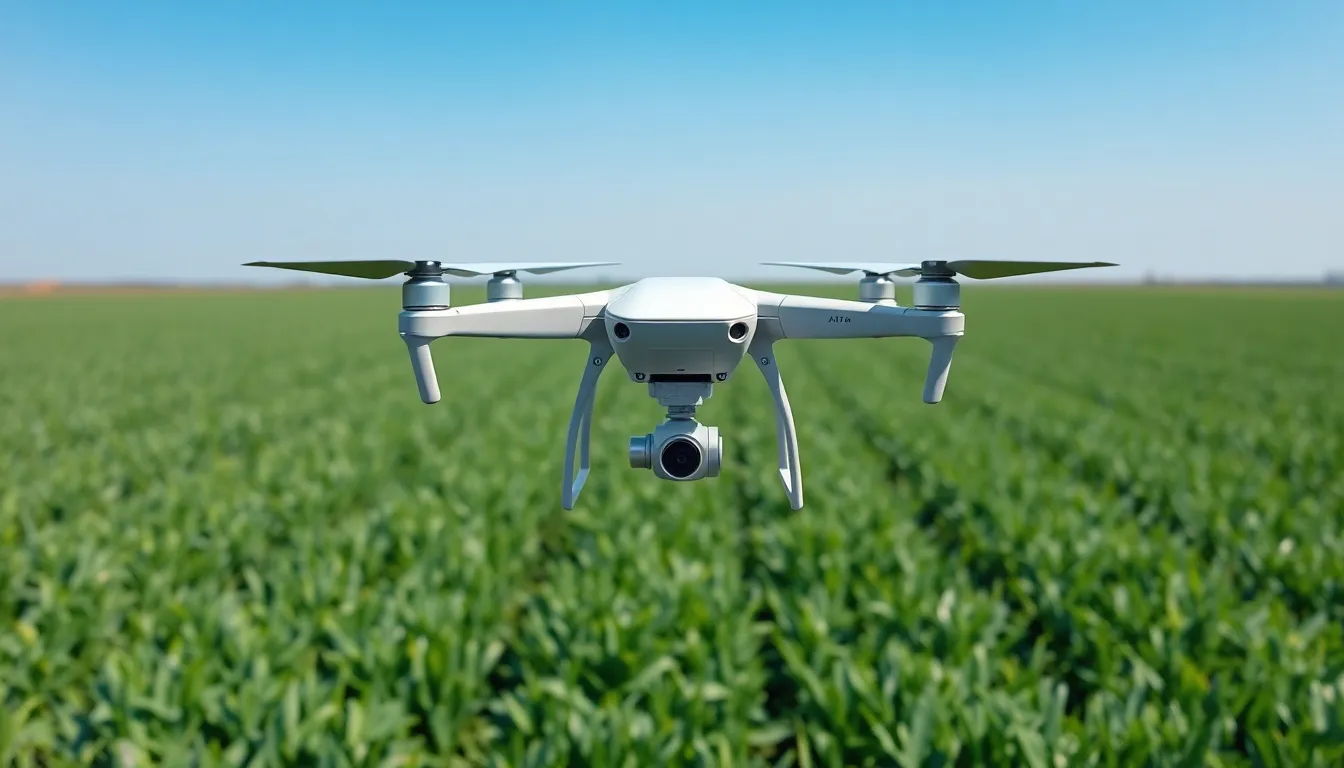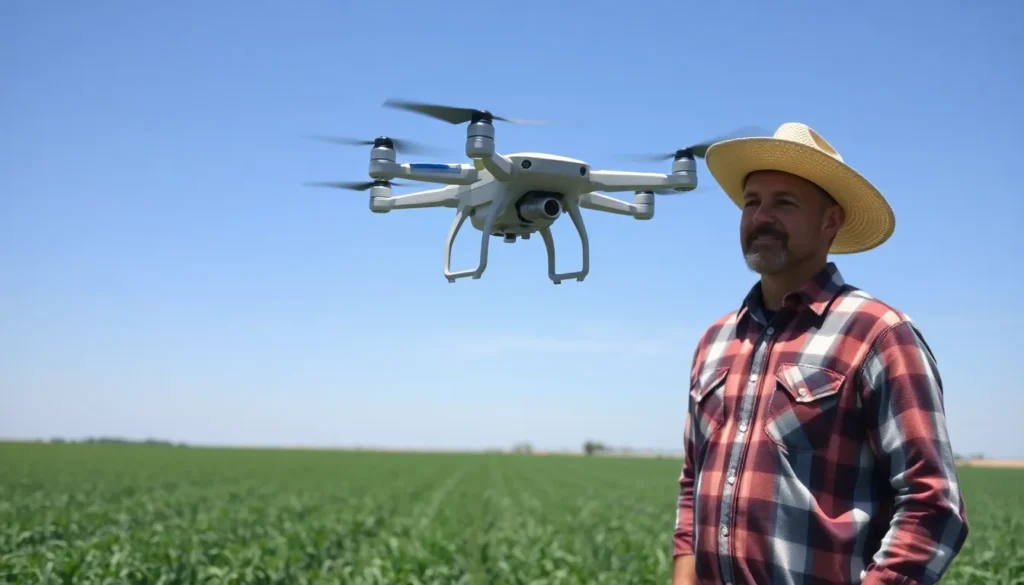In a world where technology seems to be evolving faster than a caffeinated squirrel, drone technology has soared to new heights—literally! These flying marvels aren’t just for capturing stunning aerial selfies or delivering snacks to your doorstep; they’re revolutionizing industries from agriculture to filmmaking. Imagine a future where your crops get a bird’s-eye view and your favorite blockbuster is shot entirely from the sky.
Table of Contents
ToggleOverview of Drone Technology
Drone technology continues to evolve, showcasing its versatility across multiple sectors. Unmanned aerial vehicles (UAVs) serve various purposes, from recreation to critical industrial applications. In agriculture, drones enhance productivity through precise aerial crop monitoring and targeted pesticide applications. Filmmaking benefits from the unique perspectives drones offer, capturing stunning visuals previously difficult to achieve.
Commercial industries incorporate drones for efficient delivery services, drastically reducing shipping times. Public safety agencies utilize drones for search and rescue missions, improving response times during emergencies. Environmental monitoring involves drones for assessing change and collecting data in hard-to-reach areas.
Different types of drones exist, including quadcopters and fixed-wing models, with each designed for specific tasks. Technological advancements like GPS integration and real-time data transmission enhance drone capabilities, making them reliable tools for various applications. Regulatory frameworks continue to adapt, addressing the need for safe drone operation in increasingly congested airspaces.
The market for drone technology is expanding rapidly. Statista reports projected revenue of approximately $42.8 billion by 2024, reflecting the growing adoption of drones in numerous industries. This evolution demonstrates the pivotal role of drones in enhancing efficiency and transforming conventional practices. As new applications emerge, the potential for drone technology to reshape industries will only increase.
Applications of Drone Technology

Drones find extensive applications across various sectors, significantly changing operations in those fields.
Commercial Uses
Retail and logistics companies utilize drones for efficient delivery of goods. Speedy delivery reduces shipping times, enhancing customer satisfaction. In agriculture, drones conduct aerial crop monitoring, providing farmers with essential data to optimize yields. Photographers and filmmakers take advantage of drones for stunning aerial shots, enriching visual storytelling. Infrastructure inspections often leverage drones to assess bridges and power lines, improving maintenance planning. Overall, businesses are increasingly adopting drone technology to streamline operations and increase productivity.
Military Applications
Military organizations employ drones for surveillance and reconnaissance missions. Enhanced situational awareness occurs through real-time data gathering, allowing for informed decision-making. Combat zones often see drones used for tactical support, minimizing risks to personnel. Forces utilize unmanned aerial vehicles for targeting and assessing threats more accurately. Additionally, drones assist in logistical support operations by delivering supplies to hard-to-reach locations. Their versatility makes drones vital components in modern military strategy, adapting to various operational needs.
Benefits of Drone Technology
Drone technology offers significant advantages across multiple sectors. These benefits include cost efficiency and enhanced data collection, which contribute to improved operational effectiveness.
Cost Efficiency
Cost efficiency stands out as a prominent benefit of drone technology. Businesses save on labor costs by using drones for tasks like deliveries, reducing the need for extensive manpower. Shipping times decrease, enabling faster service without escalating expenses. For instance, companies utilizing drones for logistics cut costs significantly, leading to better profit margins. Maintenance costs also decline since drones can inspect infrastructure and identify issues early. Organizations that adopt drones see a substantial return on investment over time, reinforcing economic viability.
Enhanced Data Collection
Enhanced data collection represents another key advantage of drone technology. Drones capture high-resolution images and videos that provide critical insights, particularly in agriculture and environmental monitoring. Farmers use drones for detailed aerial surveys, allowing precise assessment of crop health and resource allocation. Similarly, public safety agencies leverage drones to collect real-time data, improving situational awareness during emergencies. The ability to gather accurate information quickly greatly aids decision-making processes, ensuring timely responses. Data collected via drones often offer a level of detail unattainable through traditional methods, enhancing operational effectiveness across various sectors.
Challenges and Limitations
Drone technology faces several challenges and limitations that can hinder its widespread adoption. These challenges include regulatory issues and safety concerns.
Regulatory Issues
Regulations significantly impact drone operations across various regions. Federal Aviation Administration mandates establish specific guidelines for commercial drone use. Compliance with these regulations can complicate operations, especially for businesses aiming to implement drone solutions. Local restrictions, such as no-fly zones, also create challenges for commercial applications. The evolving regulatory landscape may adjust to accommodate advancements in technology, yet current legislation frequently lags behind the rapid pace of innovation. Consequently, companies must navigate these restrictions while seeking to explore new opportunities in drone use.
Safety Concerns
Safety is a major concern surrounding drone usage. Unmanned aerial vehicles can pose risks to people and property if not operated correctly. Instances of drone malfunctions or operator errors can lead to accidents, raising public apprehension. Furthermore, privacy issues arise as drones capture images and data without the consent of individuals. Organizations must ensure they follow safety guidelines to mitigate these risks and gain public trust. Continuous technological advancements, like improved obstacle detection systems, contribute to enhancing safety over time, yet challenges remain prevalent in this evolving field.
Future of Drone Technology
The future of drone technology holds significant promise across various sectors. Forecasts predict the global drone market will reach approximately $42.8 billion by 2024. This growth reflects widespread adoption in fields like agriculture, logistics, and environmental monitoring.
Commercial applications are set to expand, especially in delivery services. Businesses increasingly rely on drones to enhance shipping efficiency, aiming to meet rising consumer expectations. Retailers often use UAVs for quicker deliveries, which boosts customer satisfaction and loyalty.
Innovations in drone technology will likely focus on improved autonomy and AI integration. Enhanced machine learning capabilities enable drones to perform complex tasks, such as real-time data analysis during agricultural monitoring. Farmers can use these insights to make informed decisions that optimize crop yields.
Military applications will continue to evolve, emphasizing unmanned operations. Drones will increasingly support surveillance and reconnaissance missions, enhancing situational awareness for defense operations. Real-time data-streaming capabilities provide strategic advantages in combat situations.
Regulatory frameworks are expected to adapt alongside technological advancements. As drone technology matures, governments are likely to establish clearer regulations governing their use. Compliance with safety guidelines will remain essential for companies, fostering public trust in drone operations.
Public safety agencies are also exploring drones for disaster response and management. These UAVs assist in search and rescue missions, significantly improving emergency response times. Their ability to operate in challenging environments makes them invaluable tools for first responders.
The future is bright for drone technology, with ongoing advancements poised to reshape industries. Continual investment in research and development will drive innovations, ensuring drones become integral to everyday operations across multiple sectors.
Drone technology is rapidly transforming various industries by enhancing efficiency and providing innovative solutions. Its applications range from agriculture to logistics and public safety, showcasing its versatility and potential for growth. As businesses increasingly adopt drones, they benefit from cost savings and improved data collection that drive operational effectiveness.
Despite challenges such as regulatory hurdles and safety concerns, the future of drone technology looks promising. With advancements in autonomy and AI integration, drones are set to perform more complex tasks and enhance real-time decision-making. As regulations evolve to keep pace with technology, the integration of drones into everyday operations will likely become more seamless, further reshaping industries and improving services.










